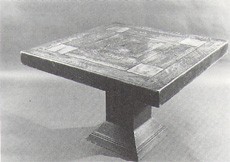
Table, designed and made by Charles Sumner Greene, Pasadena, 1900. Wood. (Private collection; photo, Marvin Rand.)
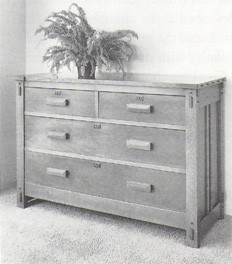
Bureau, designed by Charles Sumner Greene and Henrv Mather Greene for the Jennie Reeve house, Long Beach, California, probably Pasadena, ca. 1904. Oak and cedar. (Private collection; photo, Marvin Rand.)
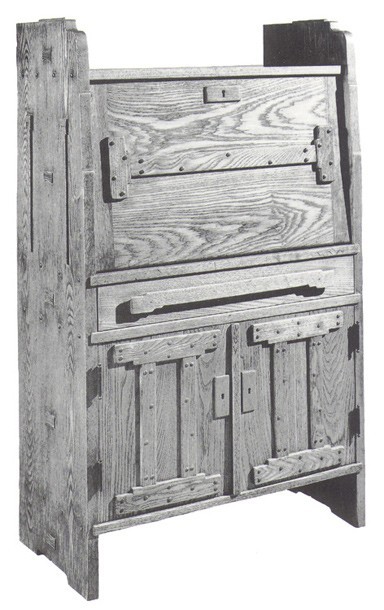
Desk, designed by Charles Sumner Greene and Henrv Mather Greene for the Adelaide Tichenor house, Long Beach, California, probably Pasadena, ca. 1904. Ash. (Private collection; photo, Marvin Rand.)
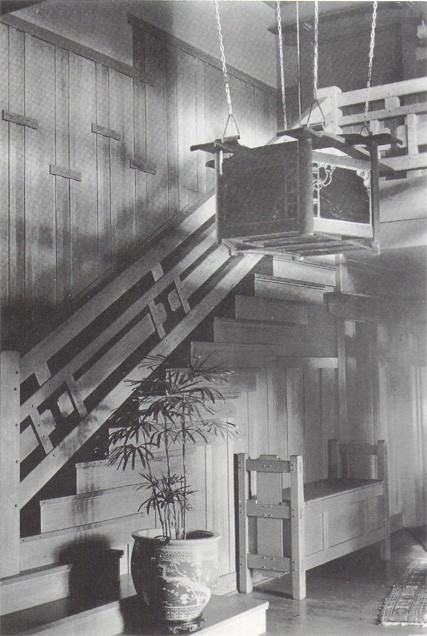
Entry hall in the Henry Robinson house, Pasadena, 1906—1907. (Photo, Documents Collection, Charles Sumner Greene Collection (1959-1) Environmental Design Archives, University of California, Berkeley.)
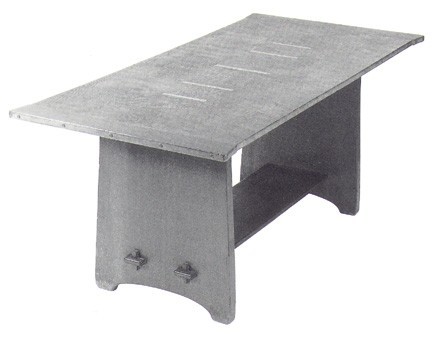
Library table, designed by Charles Sumner Greene and Henry Mather Greene for the Henry Robinson house, Pasadena, 1906—1907. (Private collection; photo, Marvin Rand.)
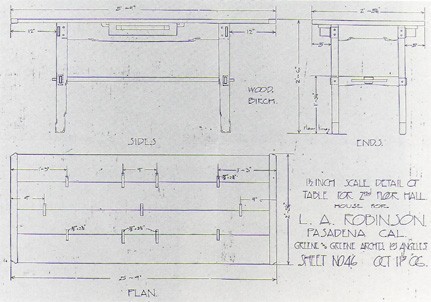
Drawing of a hall table in the Henry Robinson house, Pasadena, 1906—I907. (Photo, Drawings and Archives, Avery Architectural & Fine Arts Library, Columbia University in the City of New York.)
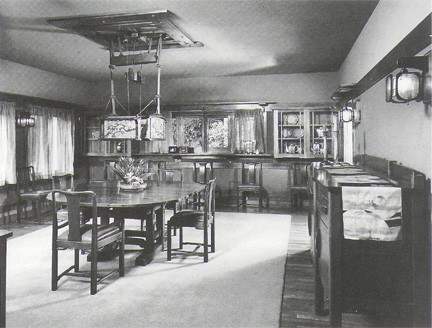
Dining-room furniture, designed by Charles Sumner Greene and Henry Mather Greene and made by the Hall shop for the Henry Robinson house, Pasadena, 1906—1907 (in recreated setting). Mahogany. (Huntington Library, Art Collections, and Botanical Gardens; photo, Marvin Rand.)
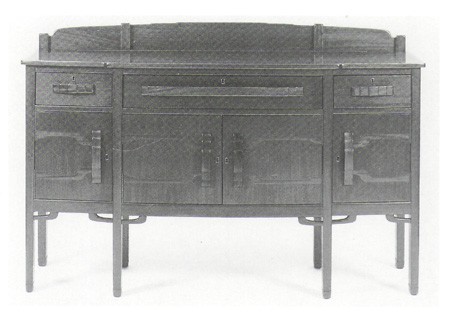
Sideboard, designed by Charles Sumner Greene and Henry Mather Greene and made by the Hall shop for the Henry Robinson house, Pasadena, 1906—1907. Mahogany. (Huntington Library, Art Collections, and Botanical Gardens; photo, Marvin Rand.)
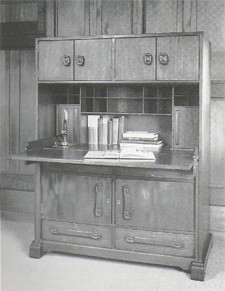
Desk, designed by Charles Sumner Greene and Henry Mather Greene and made by the Hall shop for the Henry Robinson house, Pasadena, 1906—1907 Mahogany. (Huntington Library, Art Collections, and Botanical Gardens; photo, Marvin Rand.)
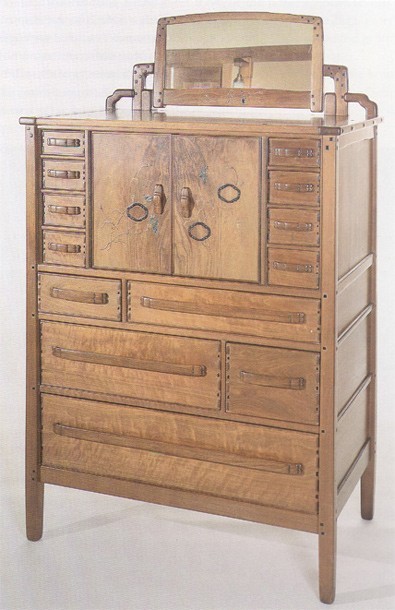
Chiffonier, designed by Charles Sumner Greene and Henry Mather Greene and made by the Hall shop for the master bedroom of the David Gamble house, Pasadena, 1908—1909. Mahogany, ebony, and oak; fruitwood inlay. (The Gamble House; photo, Marvin Rand.)
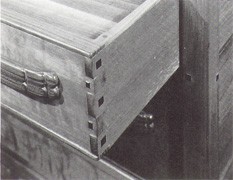
Detail of drawer construction of the chiffonier in fig. 10. (Photo, Marvin Rand.)
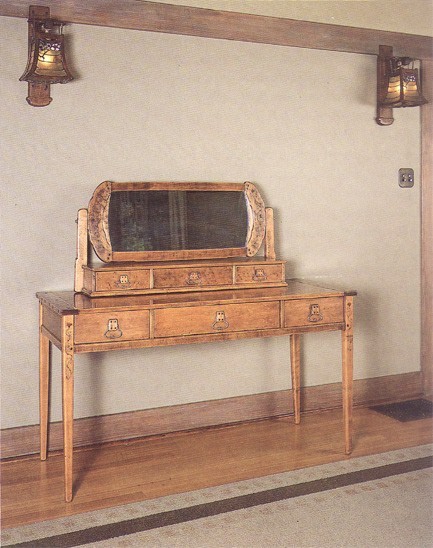
Dressing table, designed by Charles Sumner Greene and Henry Mather Greene and made by the Hall shop for the guest room of the David Gamble house, Pasadena, 1908—1909. Maple, ebony, and oak; silver and ivory inlay. (The Gamble House; photo, Marvin Rand.)

Detail of drawer construction of the table in fig. 12. (Photo, Marvin Rand.)

Armchair, designed by Charles Sumner Greene and Henry Mather Greene and made by the Hall shop for the Robert Blacker house, Pasadena, 1908—1909. Mahogany, ebony; fruitwood, silver, and copper inlay. (Los Angeles County Museum of Art, gift of Max Palevsky in honor of the museum's twenty-fifth anniversary.)
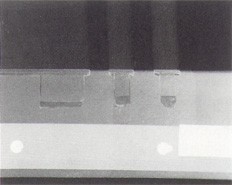
Photograph of X ray of detail where the splat is joined to the rear seat rail of the chair in fig. 14. (Photo, Los Angeles County Museum of Art.)

Photograph of X ray of detail where the splat is joined to the crest rail of the chair in fig. 14. (Photo, Los Angeles County Museum of Art.)
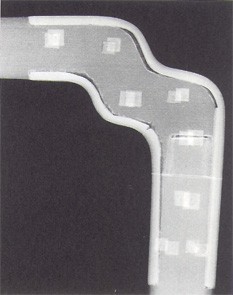
Photograph of X ray of detail where the arm is secured to the front post of the chair in fig. 14. (Photo, Los Angeles County Museum of Art.)
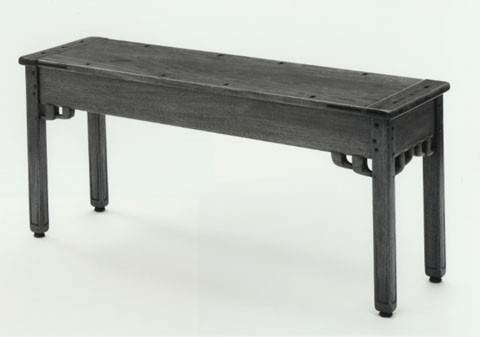
Bench, designed by Charles Sumner Greene and Henry Mather Greene and made by the Hall shop for the Robert Blacker house, Pasadena, 1908—1909. Mahogany, ebony, oak. (Courtesy, Museum of Fine Arts, Boston. Reproduced with permission. ©Museum of Fine Arts, Boston. All rights reserved.)
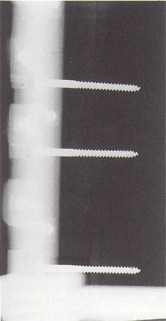
Photograph of X ray of detail where the batten is secured to the top board of the bench in fig. 18. View is from above the seating surface. (X ray ©Museum of Fine Arts, Boston; photo, Edward S. Cooke.)

Detail of underside of the bench in fig. 18. (Photo, ©Museum of Fine Arts, Boston.)

Photograph of X ray of detail where the knee bracket and rail are secured to the front leg of the bench in fig. 18. (X ray ©Museum of Fine Arts, Boston; photo, Edward S. Cooke.)

Cabinet, designed and made by Gottlob Karl Lapple, Pasadena, 1915—1930. Oak, ebony, and yellow poplar. (Private collection; photo, Edward S. Cooke.)
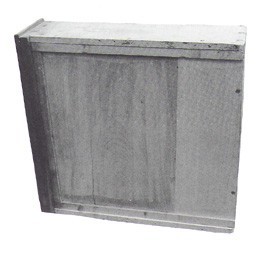
Detail of drawer from the cabinet in fig. 22. (Photo, Edward S. Cooke.)

Sideboard, designed by Charles Sumner Greene and Henrv Mather Greene and made by the Hall shop for the William Thorsen house, Berkeley, California, 1909—1910. Mahogany and ebony; fruitwood and motherof pearl inlay. (Huntington Library, Art Collections, and Botanical Gardens; photo, Marvin Rand.)
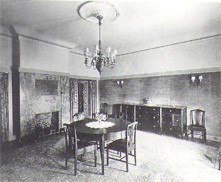
Dining room in the Cordelia Culbertson house, Pasadena, 1911—1913. Furniture designed by Charles Sumner Greene and Henry Mather Greene and made by the Hall shop. (Photo from original in the Greene and Greene Library, Huntington Library, Art Collections, and Botanical Gardens.)
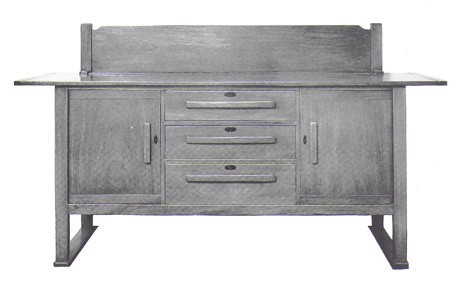
Sideboard, designed by Charles Sumner Greene and Henry Mather Greene and made by the Hall shop for the Charles Sumner Greene house, Pasadena, 1912—1913. Mahogany and oak. (Private collection; photo, Marvin Rand.)

Box, Hall Manufacturing Company, Pasadena, 1918—1921. Redwood. (Private collection; photo, Edward S. Cooke.)
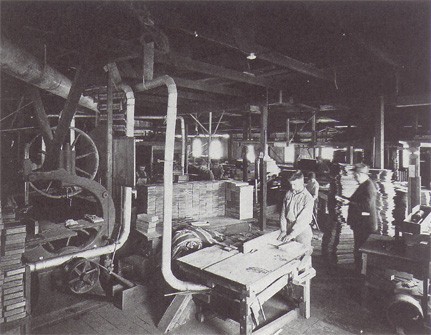
Interior of the Hall Manufacturing Company, Pasadena, 1918—1921. (Photo from original in the Greene and Greene Library, Huntington Library, Art Collections, and Botanical Gardens.)

Gaming table and chairs, designed by Charles Sumner Greene and probably made by John Hall with carving by Charles Sumner Greene for the Mortimer Fleishhacker house, Woodside, California, 1923—1925. Mahogany; leather. (Photo from original in the Greene and Greene Library, Huntington Library, Art Collections, and Botanical Gardens.)
Furniture designed by Pasadena, California, architects Charles Sumner Greene (1868-1957) and Henry Mather Greene (1870-1954) has attracted the attention of many arts and crafts enthusiasts. The Greenes' concern with the inherent beauty of wood, incorporation of visible joinery, reliance on local materials or imagery for decoration, and commitment to the integration of interior furnishings with architecture resulted in what many writers have described as the ultimate in arts and crafts furniture. Scholars have often attributed the success of the brothers' furniture to their knowledge of and affinity with the materials and processes. Both of the Greenes took woodworking courses at Calvin Milton Woodward's Manual Training School in St. Louis before enrolling in the architecture program at the Massachusetts Institute of Technology. Charles, in particular, enjoyed woodworking: he possessed enough skill to make a table as a wedding present for his wife in 1900 (fig. 1); carved wooden furniture and architectural elements throughout his career; and eagerly visited the shop where furniture makers executed his designs.[1] An examination of Greene-designed furniture, however, reveals the critical role of the professional craftsmen who contributed to the look of Greene and Greene furniture.
The Greenes first demonstrated an interest in the interior furnishings of the houses they designed in 1902. Charles's exposure to the English arts and crafts movement during his honeymoon there in 1901 and the publication of the first issue of The Craftsman in the fall of the same year inspired them to integrate movable furniture with architectural fabric. Initially they relied upon commercially available products such as Gustav Stickley furniture, Rookwood and Tiffany ceramics, and Navajo rugs.[2]
For two commissions in 1904, the Jennie Reeve and the Adelaide Tichenor houses in Long Beach, the Greenes began to design custom furniture. The Reeve bureau (fig. 2) and the Tichenor desk (fig. 3), for example, manifest a direct craftsman influence. The two slab sides with a fall-front writing surface over heavily battened doors resemble one of Stickley's earliest desk designs. The Greenes drew from Stickley's formal vocabulary and duplicated his structural decorative conventions such as the butterfly splines on the side of the desk and the projecting through-tenons of the bureau. Although the Greenes added a few new Asian motifs, such as the lift in the drawer pull and the setback along the front edge of the sides, their work of this period remained very much within the Anglo-based craftsman tradition: severely rectilinear, overengineered forms made from thick-dimensioned stock; surface decoration reliant on the figure of ring-porous native hardwoods such as oak and ash; and visible joinery that stressed handcraftsmanship.[3]
It is not known who built the Greene-designed furniture of this period. Several firms in Pasadena could have produced such work. Carl Enos Nash advertised himself in 1904 as a "builder of fine furniture and mantels" and in 1906 as a "designer of furniture." Another possibility was Ye Arts and Crafts Company, manufacturers of "artistic furniture," which William L. Leishman purchased in egos and renamed Crown City Manufacturing Company. The new firm specialized in planing and milling but also advertised "mission furniture" in 1906. A third possibility was Pasadena Manufacturing Company, a large shop that offered doors, sash, blinds, and moldings.[4]
It is more likely that the Greenes turned to one of the two millwork firms than to an individual like Nash. Since the 1870s millwork shops, particularly those that offered stairbuilding and mantels, had worked closely with architects. These firms offered particular advantages to designers: they worked according to estimates and specified budgets, they could produce a quantity of related furniture, and they were used to following the specifications of a designer rather than introducing their own style. As Chicago architect Elmer Gray, who also worked in Pasadena, wrote in 1907: "The architect must be at the head in all attempts to bring his work and that of craftsmen closer together. All such attempts should begin on the working basis of the cooperation of an architect's office with a practical (but not visionary) craftsman's shop." Millwork shops, rather than small cabinetmaking shops, were ideally pliant and efficient manufacturers who would suppress their own aesthetics.[5]
For the Greenes 1906 proved to be a pivotal year. Whereas in some commissions, such as the Caroline DeForest house and the Josephine van Rossem house, the Greenes retained many of the same craftsman woodworking conventions, some of the furniture they designed for the Henry Robinson house in the last half of 1906 reflected a new direction. Echoing the constructional and aesthetic conventions of the Tichenor and Reeve work were the oak and cedar woods and pinned through-tenon construction of the entry-hall shoe bench (fig. 4); the Voysey inspired shape, stretcher with wedged through-tenons, and inlaid splines of the library table (fig. 5); and the pinned and wedged through-tenons of the birch hall table (fig. 6). But the furniture and fittings of the dining room (figs. 7, 8) and part of the living room (fig. 9) were dramatically different in form, materials, and technique. The designs were based on historical examples such as Chinese chairs of the Ming period, neoclassical sideboards, and leafed pedestal tables. This historical grace was underlined by thin-dimensioned verticals and softened, modeled edges. This furniture was executed in mahogany, a material preferred by cabinetmakers for its good weight-strength ratio, few imperfections, consistent grain structure, workability, and capacity to take an even finish. The joinery in this furniture also betrays the Greenes' more technically sophisticated approach: the dining-room armchairs feature splined miter joints at the juncture of the arms and front posts; the living-room desk features a carcass assembled with miter joints and well-fit doors and drawers; the weight boxes in the dining-room chandelier feature finger joints; and all the furniture has rounded edges and smooth surfaces with no visible tool marks. The base of this technical system was accomplished cabinetmaking rather than self-conscious "craftsmanship."[6]
Many scholars have attributed the change in approach so evident in the Robinson dining and living rooms to the continued developments and refinements of the Greenes' own vision. Evolving aesthetics, however, do not account for the extent of changes. The Robinson furniture embodies a whole new approach to furniture. It is different from the inside out, from the structure of the design, to the technical means to carry out the design, to the final appearance. Such a dramatic change raises the question: What caused the new direction? The answer can be found more on the shop floor than on the drawing board: the Robinson house was the first new construction on which the Greenes worked with Pasadena contractor Peter Hall (1867-1939) and his brother John Hall (1864-1940).
John and Peter Hall had been born in Stockholm, Sweden, but had immigrated to Illinois by 1872. Peter moved to Pasadena in 1886 and gained a reputation as a master stairbuilder. He worked in Seattle, Washington, and Port Townsend, Oregon, from 1889 through 1891, then returned to Pasadena and worked for the millwork firm known as Pasadena Manufacturing Company. John also worked for this firm in the 1890s. Although Peter left the company in 1900 and set up his own contracting firm in 1902, John remained in the employ of the company. With a reputation for fine workmanship, John became a foreman in 1899 and remained so into 1906.[7]
The Greenes had initially worked with Peter Hall on the renovations to the Todd Ford house in 1905 and must have been impressed with his expertise and ability to work according to their designs. With the confidence of the Greenes ensuring business, Hall took out a building permit to erect a one-story carpentry shop on South Raymond Avenue on June 15, 1906, just as construction yon the Robinson house began. In the next month, they also began work on the William Bolton house. Although construction of the houses commenced in the summer of 1906, the furniture came later. Traditionally scholars have dated the Robinson furniture at 1906, but three pieces of circumstantial evidence suggest that it was built in 1907. First, John Hall was still listed as a foreman at the Pasadena Manufacturing Company in the Pasadena Directory of 1906, compiled in the summer and published in September of that year. Second, drawings for the Robinson hall table, which preceded actual production, were dated October 1906. Finally, according to oral history Peter Hall did not expand the space, machinery, and personnel of his shop until 1907. Simultaneous production of architectural fittings-doors, sashes, paneling, and trimand furniture would have necessitated these additions.[8]
The furniture for the Robinson and Bolton houses embodies a distinctive wood system characterized by millwork preparation and joinery and handwork fitting, decorating, and finishing. Furniture made for the David Gamble house and the Robert Blacker house suggests that this system was further refined in 1908 and 1909. Close analysis of several pieces of furniture reveals the details of the woodworking system.[9]
The chiffonier for the Gamble master bedroom (fig. 10) features carcass joinery typical of the Halls' work.[10] The Halls cut, shaped, scraped, and sanded the rails, stiles, and panels first; then cut the joints and assembled the components. In the process of assembly they did not fit intersecting parts in the same flush plane but used the offset joints to provide surface variety. Although they did not use the time-consuming practice of paring the joints to be flush, they did take the time to cope or house many of the joints. The decorative treatment of the chiffonier also reflects where they focused labor-intensive work: softly modeled drawer pulls, smoothed square ebony plugs for decorative rhythm, and the asymmetrical inlay and sword-guard appliqué inspired by Japanese design. These details provided the visual link between the various other furniture forms of the room.
The drawer construction of the chiffonier (fig. 11) is particularly noteworthy. The front corners are joined with finger joints that the Halls cut with a table saw or multiple dado cutters. After cutting the fingers the craftsman smoothed the edges and end grain and then screwed the parts together with countersunk screws that were concealed by modeled ebony plugs. The backs of these drawers were simply butted against the inside surface of the drawer sides and screwed in place. An ebony cover strip with a dovetailed joint at the corner was screwed to the top of the drawer linings, and even this detail was produced with machinery. One large ebony board had a dovetail key cut with a shaper, whereas another had a dovetail pin cut with a matching shaper blade. The craftsman then used a table saw to saw off several different thin strips. For the bottoms of these drawers, plywood was floated in machine-cut grooves along the inside of the drawer front and sides. These boards were screwed to the underside of the drawer back. An oak center strip was screwed to the underside of the drawer and slid within a matching rabbeted strip along the upper surface of the fulldepth dust panels. This center guide ensured the proper action of the drawer even if the opening was oversize or the drawer out of square.
The dressing table in the guest room of the Gamble house reveals a second type of drawer construction used by the Hall shop (figs. 12, 13). The drawer fronts are secured to the sides with blind tongue and groove joints that were easily and tightly cut on a table saw or a shaper.
The drawer construction seen on these two pieces of Gamble house furniture is unparalleled in American furniture and is more typical of Scandinavian modern work.[11] And the expedient preparation and joinery on each contrasts with the time-consuming inlay, detailing, scraping, sanding, and finishing.
Close analysis and X rays of several objects from the Blacker house also provide valuable information about the Hall shop. On the living-room armchair (fig. 14), X rays of the joints where the splat is attached to the rear seat rail (fig. 15) and to the crest rail (fig. 16) reveal that the mortises were chopped out very roughly before the splat was finished. Once finished, the splat then served as a pattern to scribe tight fitting, housed mortises in the seat and crest rails. The same approach characterizes the joints that secure the crest rail to the rear post rail (fig. 16) and the arm to the front post (fig. 17) . In the former the mortise in the crest rail is overcut but presumably has tight-fitting cheeks since there is no evidence of a pin or screw securing the joint. The groove for the ebony beading ensured this tight fit; an X ray, indicates that the maker chopped from the groove into the mortise, the thickness of the former determining that of the latter. The rough depth and undercut ends of the groove also demonstrate how the maker worked expediently yet accomplished a finished look. The beading fits tightly, adds some strength to the joint, and provides a contrasting detail to detract one's eye from the joint line. Along the front-arm joint a tight-checked tenon is glued into a deeply cut mortise with width determined by the groove, applied decorative ebony plugs are set into holes that had been pilot-drilled and squared off with a chisel, and an ebony beading is pieced and bent along a groove extending beyond the joint, all further demonstrations of the same conventions.
The top of a bench (fig. 18) also demonstrates how the Halls constructed the tops of their case furniture and tables to prevent warping and to allow for the movement of the wood. A wide mahogany surface had a tongue cut on each end that fit into a groove cut along the inside of a batten. Two screws through the end of the batten into the wide board secured the middle of the board, but two screws placed near the outside edges of the batten were fit with slotted washers in oversized mortises (fig. 19). Ebony plugs conceal all four countersunk screws on each batten. The batten was then housed over the top of the frame and secured with ebony-covered, countersunk screws. The slotted washers allowed the large board to expand and contract as humidity changed. The Halls also made allowance for across-the-grain wood movement by using metal buttons with slotted holes to secure the top board to the frame (fig. 20) . X rays of the joints where the frame was secured to the legs also reveal that they employed housed mortises. The maker secured the brackets to the rail with screws and chopped deep mortises in the legs, an approach presumably dictated by the sequence of assembly (fig. 21).
Such a concern with machine production, wood expansion, and modeled surfaces is not typical of American work in the 1900-1910 era and is often associated with Scandinavian furniture produced in the early twentieth century. The Scandinavian basis of this woodworking tradition is given additional credence by examination of the woodworkers in the Hall shop (see appendix). The majority of the skilled positions were held by Scandinavians. Some had immigrated in the 1890s, but two, David Swanson and Bror Krohn, the men responsible for the Gamble house bedroom and guest-room suites, had arrived more recently. Fellow Swedes Erik Peterson and George Nelson were the premier chairmakers who produced prototypes that others in the Hall shop then copied. The identification of a specific Scandinavian approach is also born out by Swanson's reference to the blind tongue-and-groove drawer joint as a "Swedish joint."[12]
The dominance of the Scandinavian system is apparent in furniture produced by Gottlob Karl Lapple, a German-trained craftsman who worked for Hall' from 1908 until about 1913. In furniture he made for his own family (fig. 22), Lapple employed modeled drawer pulls, softened edges, and square plugs of ebony to conceal screwed construction, but he relied on a different drawer system. He dovetailed the corners and let the solid bottoms into rabbets cut along the bottom edges of the drawer fronts and sides, securing them with strips that he screwed in from the sides (fig. 23) . (Although trained in the dovetailed tradition and reliant on it when working on his own, Lapple never used it in the Hall shop. None of the Halls' furniture has dovetailed drawers.)
Between 1907 and 1913, the Halls made about 4oo pieces of furniture while working almost exclusively for the Greenes. The furniture for the other "ultimate bungalows" designed by the Greenes-the Charles Pratt house in Ojai and the William Thorsen house in Berkeley (both designed in 1909) reveal the same woodworking conventions found on the Gamble and Blacker work. The Thorsen furniture is said to have been made by a Scandinavian craftsman from the Hall shop (fig. 24).[13] For the Cordelia Culbertson house in Pasadena (designed in 1911), the Halls built more historic forms (fig. 25) but retained the joinery systems, exquisite inlay, and fine oil finishes of their earlier work.
A simpler form without inlay from this same period was a sideboar made in late 1912 and early 1913 for Charles Sumner Greene himself (fig. 26) . Its bill survives and indicates the favored materials and costs involved in a plainer piece of furniture:[14]
| 186 3/4 hr. @ 50 128 ft. Mahg. @ 25 oak 33 ft. 5 ply @ 29 Hardware Plating Express |
93.37 32.00 .30 9.57 4.07 1.25 .50 |
| 141.60 |
The maker used mahogany for the carcass and drawer linings; plywood for the drawer bottoms, carcass back, and bottom; and oak for the center guides of the drawers. Nevertheless the maker's time accounted for two thirds of the cost of this basic sideboard.
Sometime toward the end of 1913, the furniture business declined. The Halls had worked almost exclusively for the Greenes for seven years and were affected by the sudden decrease in commissions for the architects' integrated bungalows and houses. At this point many key employees left the Halls. Swanson and Anton Erikson moved to the Binderheim Studios, an interior decoration firm that offered individuals complete mural, upholstery, and fine furniture-making services. Its cabinetmaking shop featured "various machines of the latest and best designs" including a jointer, table saw, thickness planer, and shaperand a bench room for fine handwork. Sven Carlson went to Crown City Manufacturing, and by 1919 Lapple had joined him.[15] Others may also have left the Halls; however the directories for these years do not consistently specify the places of employment.
John Hall continued making furniture for the Greenes, and in 1917 he was working on a commission for Mrs. Dudley Allen. Charles Sumner Greene had moved to Carmel, California, but his father kept him apprised of business with Hall by mail.[16]
As the furniture business began to decrease, the Halls used their machinery for different purposes. By 1918 their men were using table saws and shapers to mass-produce distinctive redwood boxes with finger-joint corners, shaper-produced moldings, and smooth finish-for dried fruits (figs. 27, 28). This venture ended in 1921 when a fire destroyed the 200-foot long, one-story frame structure. Among the losses totalling $20,000 were "thousands of boxes in various stages of completion, as well as many thousands of feet of seasoned redwood and valuable machinery."[17]
After the fire the Halls did not rebuild their shop. Peter focused upon his contracting business, building St. Paul's Cathedral in Los Angeles in 1923, St. Alden's Chapel in Westwood, and many homes in the Pasadena and Los Angeles area. John, always in the background, continued to work as a finish carpenter and cabinetmaker in the Pasadena area, often with his brother. The furniture Charles Sumner Greene designed for the Mortimer Fleishhacker house in Woodside (1923) suggests that John Hall continued to do occasional work for Greene. Although tradition maintains that Greene designed and made this furniture by himself in his own shop, the structural conception and the joinery on the game table and chairs suggest a professional hand and share many features with the Halls' work (fig. 29) . It is a bit more simplified than the work of the 1908 to 1913 period but such a change may be due to Hall working without the specialized help of the full shop yet drawing from the approaches and techniques of that period. Greene may have done all the carving, but it is unlikely that he could have built the entire suite by himself.[18]
The Halls' withdrawal from furniture making was completely tied to the collapse of the Greene commissions for interior furnishings. Opportunities for skilled millwork cabinetmakers continued in Pasadena. Swanson and Erikson's firm and its successor, Swanson and Peterson, emerged as one of the specialty firms that catered to the new demands for office and domestic furniture. They offered a broad range of services: "jobbing, manufacturing, contracting and trading in lumber, wood-work, building supplies, cabinet work, store and office fixtures, stairwork, wood-carving, wood-turning, mill and factory work; furniture, office, store and cabinet polishing and finishing; construction and installation of store fronts and interiors; glazing, and all necessary, convenient and connected supplies." Walter Gripton, who took over Pasadena Manufacturing Company in 1916, offered many of the same services.[19]
Examination of the furniture built by the Halls' shop demonstrates how important the craftsmen and specialists were to the final product. The Halls and their employees played an integral role in the development and final appearance of the Greene and Greene style. In terms of American twentieth-century furniture history, the furniture is also important as the first true example of Scandinavian modern furniture design. The fit to the period and the combination of machined production with handworked finish has provided the enduring legacy of the furniture.
ACKNOWLEDGMENTS
For assistance in the gathering of information and the analysis of the furniture, I thank the following: Randell Makinson and Ted Bosley of the Gamble House in Pasadena; Tim Gregory and Susan Coffman at Pasadena Historical Society; Doris Gertmenian at Greene and Greene Library; the staff of the Pasadena Public Library; Leslie Bowman and the Conservation Center at the Los Angeles County Museum of Art; Robert Walker, Letitia Stevens, Steve Stvenstrom, Richard Newman, and Kate Duffy at the Museum of Fine Arts, Boston; Brian Kelly of the North Bennett Street School; Lewis and Roy Gray; Kathryn Swanson; Marilyn Zeiss; Hank Gilpin; Cheryl Robertson; Lee Macneil; and Carol Warner.
For an estimate of the total number, see Randell Makinson, Greene & Greene and the American Arts and Crafts Movement (San Marino, Calif: Huntington Library, Art Collections, and Botanical Gardens, 1991), p. 5. On the Thorsen house furniture, see Makinson, Greene & Greene Architecture, pp. 174—78; Makinson, Greene & Greene Furniture, pp. 88—93; and Clark, Arts and Crafts, p. 83.
Pamphlet of the Binderheim Studios, about 1915, privately owned by a descendant of David Swanson; Thurston's Pasadena City Directory of 1913—1914; and recollections of Martha Gray, daughter of Gottlob Karl Lapple, Gamble House Craftsman file, Greene and Green Library.
